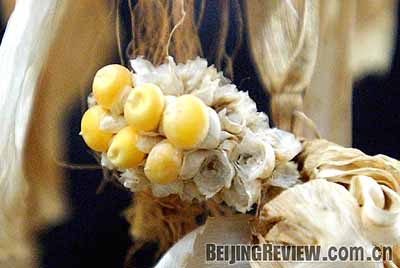| The agricultural product exhibition that opened in Shanghai on the last day of 2008 brought new hope to people with diabetes. Experts from Zhejiang University and other research institutes announced that the birth of a species of rice can lower blood sugar levels. The new strain might give patients suffering from diabetes, a disease characterized by abnormally high blood sugar levels, more freedom to choose what they eat.
 |
|
PEA-MAIZE HYBRID: The seed of the pea-maize hybrid cultivated by Zhu Peikun (XINHUA NEWS AGENCY) | Ten percent of the total starch in the mutant rice is resistant starch, 10 to 50 times the level in ordinary rice. Compared with ordinary rice, the new rice species also has more fiber, and more or less the same protein and fat.
Regular starch is rapidly digested and absorbed into the body through the small intestine. Resistant starch, by contrast, cannot be digested immediately. Since it is slowly absorbed, it is relatively slow to enter the blood.
 |
|
DISTINGUISHED SCIENTIST: Li Zhensheng, winner of the 2006 State Top Scientific and Technological Award (XINHUA NEWS AGENCY) | According to Guo Feifan, a diabetes expert at the Institute for Nutritional Sciences, Shanghai Institutes for Biological Sciences, Chinese Academy of Sciences, regular rice and flour have little resistant starch. For instance, the starch in regular prime quality rice is only 0.5 percent resistant. When diabetes patients eat regular rice, the starch quickly turns into sugar and raises their blood sugar level, which worsens symptoms and can even be life threatening. "That is why diabetes patients must carefully watch their diet and reduce intake of foods rich in sugar or starch," Guo said.
What is amazing about the mutant rice is that its resistant starch can wrap around regular starch, so that the regular starch cannot be quickly broken down into sugar by the enzymes in saliva. Resistant starch slows down digestion, while still making a person feel satiated.
In addition to stabilizing blood sugar levels in diabetes patients, resistant starch has properties that encourage colon health and help prevent colon cancer.
"It has taken us eight years to produce this mutant rice. We try to make food therapeutic through mutation and other biotechnology," said Xia Yingwu, an expert on rice cultivation and a professor at Zhejiang University. Xia is also the former president of Zhejiang Agricultural University.
By mutation, Xia referred to a modern breeding technology that triggers change in genetic information through physical or chemical means, and then selects the crop that best meets the needs of consumers. In this way, a new species or breeding method can be derived.
Hybrid crops
For thousands of years, people have grown rice in paddy fields. Last October, Zhu Peikun, President and lead scientist of Shenzhen Bioroad Biotechnology Co. Ltd., announced the birth of an upland rice species. This rice can grow in upland areas, even on dry hills, which saves a large amount of water resources.
"We produced a new type of hybrid rice by introducing sorghum chromosomes into the rice cells. Then we screened for the one that was most resistant to drought," Zhu said. Sorghum can survive in dry weather. "When it is very dry, it can temporarily become dormant."
Zhu has also cultivated a new rice species that can survive in salty and alkaline coastal land. Since 2003, he and his colleagues have been studying crossbreeding between cordgrass and rice. Cordgrass is an alien wetland plant that was introduced into China more than 40 years ago. Hybrid rice that is tolerant of salt and alkaline has been obtained by hybridizing the chromosomes of cordgrass and rice.
"This new species was obtained through chromosome hybridization technology, rather than transgenic technology or cell fusion technology," Zhu emphasized. "It is very challenging to inject chromosomes into the receiving cell, as the cell is so tiny."
In 1986, Zhu went to the United States to conduct research. In less than six months, he created a number of new species. "From then on, I was determined to modify the grass family food crops that have the largest impact on our lives."
|
